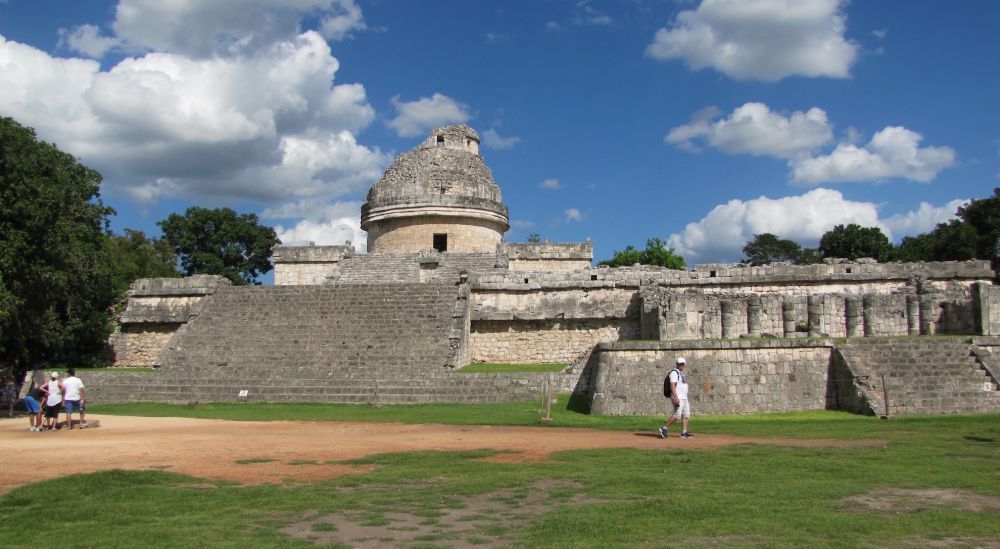Maya knew about the irregularity of the synodic period of Venus

The Caracol Observatory in Chichen Itza, the Mayan political and cultural center in the north of the Yucatan Peninsula. Photo: Gerardo Aldana
In the summer of 1952, the young physicist Richard Feynman and his beautiful wife, blonde Mary-Lou, went on a honeymoon trip to Mexico. Honeymoon honeymooners are directly related to science, because in some small town in Guatemala, "in the middle of nothing," as Feynman writes , a manuscript was put up, filled with strange symbols, pictures, strokes and dots. It was a copy of the Dresden Codex, created by the Maya, the original of which is kept in the Dresden Museum.
Richard Feynman became interested in the strokes and points in the manuscript. He already knew a lot about the Mayan Indians - for example, that they invented zero and understood astronomy in detail, being centuries ahead of European astronomers in their knowledge.
Feynman bought a copy of the code and began to wrestle with what the strokes and points mean. In the tables on the 24th page of the code, the physicist became interested in the number 584, which “was very conspicuous”. Next to the number 584 were the numbers 236, 90, 250 and 8, and the table on page 24 indicated multiples of 2920 (584 × 5) to 13 × 2920, several multiples of 13 × 2920, and various “ridiculous numbers”. The physicist suggested that all this is somehow connected with astronomy. He went to the library and found out that 583.92 days is the period of rotation of Venus, if observed from the Earth.
')
The scientist realized how deep were the knowledge of the Maya in astronomy. The numbers indicated the phases through which Venus passes, the difference between the eastern and western horizons in the land of Maya, etc. Moreover, many years later, he realized that the “ridiculous numbers” on page 24 were actually integer multiples of something closer to the correct period of 583.923 days, that is, the Maya understood that the number 584 is not quite right - and therefore made the table corrections for the correction of this number!

Dresden Codex
For many years after the work of Feynman and Eric Thompson, a well-known specialist in deciphering the Dresden Code, scientists believed that the correction table on page 24 is purely numerological in nature, that is, the synodic period is computed purely mathematically, using the most appropriate numbers .
According to Thompson, if you multiply the specified number by four, add the difference of numbers from the table, it turns out that the prediction accuracy of the orbit of Venus is one day in 4000 years. This is a very remarkable achievement of the Maya, because they conducted their observations in just a few hundred years.
It turns out that not everything is so simple. According to the theory and research of Professor Geraldo Aldana from the University of California at Santa Barbara, the numbers in the table on page 24 of the Dresden Code are not just numerological in nature, but were corrected by observations made in previous centuries to 1000 G. e. For several centuries, the Mayans systematically observed the behavior of Venus - and recorded the results. Then they calculated the duration of the synodic period of Venus 583.923 days , taking into account the irregularity of this period ! That is, the Maya made a correction according to the results of observations in the values calculated using tables.
Most likely, the observations of Venus were carried out at the Caracol Observatory in the city of Chichen Itza, in the same city in which the code was drawn up. It should be noted that the Maya did not have telescopes and other powerful optics, so they made the observations, apparently, with the naked eye. A person with very sharp eyesight is able to observe the phases of Venus in this way. In the case of the Mayan Indians, this is not one person, but many generations of astronomers with very sharp eyesight.
To test his theory, Professor Aldan organized an expedition to Copan, one of the largest archaeological sites in Honduras. This rich Mayan city was the center of the kingdom of Shukuul in the VII-VIII centuries. A lot of monuments and inscriptions have been found on the site. In Copan, the professor’s research team studied the records of the observations of Venus that correspond to the records on page 24 of the Dresden Codex.
Thus, the Mayans determined the irregularity of the synodic period of Venus about 700 years earlier than European astronomers and long before the invention of the telescope.
Geraldo Aldana believes that the Mayans didn’t carry out careful observations of Venus, not out of pure interest, but because the period of Venus was important in the Mayan calendar and played an important role in various religious rituals, when the whole city gathered and performed certain specific rites based on the observations of Venus .
The scientific article "Discovering Discovery: Chich'en Itza, the Drezden Codex Venus Table and 10th Century Mayan Astronomical Innovation" was published in the Journal of Astronomy in Culture (open access).
Source: https://habr.com/ru/post/396819/
All Articles